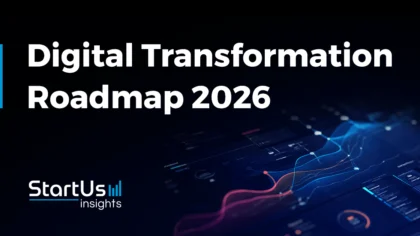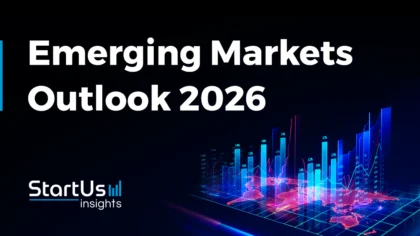Accelerate Productivity in 2025
Reignite Growth Despite the Global Slowdown
Executive Summary
- Digital Transformation Roadmap for 2026
- Assess Digital Maturity: Diagnose current readiness across leadership, culture, technology, and skills. Mature firms earn 26% higher profitability and 9% greater revenue.
- Align Goals with Strategy: Link digital priorities directly to business objectives like growth, net-zero, customer experience, or risk reduction to avoid tech-for-tech’s sake projects.
- Balance Quick Wins with Long-Term Bets: Use early visible wins to build confidence and momentum while investing in scalable architecture, analytics, and process redesign.
- Engage Stakeholders & Culture: Drive adoption with transparency, feedback, and change management; organizations with a strong cultural focus are 5x more likely to achieve breakthrough results.
- Leverage Startup & Tech Scouting: Accelerate innovation through partnerships that de-risk R&D, open new revenue streams, and provide early access to disruptive solutions.
- Scale from Pilots to Enterprise: Move beyond pilot purgatory using digital backbones, governance hubs, and workforce reskilling, ensuring successful experiments scale globally.
- Measure ROI & Adapt Continuously: Track leading and lagging indicators across cost, revenue, and adoption, using feedback loops to refine and sustain impact.
- Digital Transformation Pitfalls to Avoid
- Unclear goals, a tech-first mindset, poor change management, and weak integration with legacy systems are the major causes for failures.
- A successful transformation demands a clear vision, stakeholder alignment, process adaptation, and continuous measurement.
- Sector-Specific Transformation Roadmaps
- Manufacturing: Additive manufacturing, predictive maintenance, and supply chain digital twins tackle cost pressures and outdated infrastructure.
- Pharma: Leverages virtual care platforms, decentralized trials, and robotic process automation to improve care delivery and accelerate innovation.
- Retail & Consumer Industry: AI-driven supply chain automation, generative merchandising, and virtual try-ons meet omnichannel demands and boost margins.
- Energy & Utilities: Smart grids, AI-based outage prediction, and renewable forecasting to manage grid complexity and decarbonization goals.
- Public Sector: Digital identity systems, e-government services, and citizen experience platforms to improve service delivery, transparency, and agility.
Frequently Asked Questions
Why is a roadmap critical during an economic downturn?
It ensures digital investments stay focused on resilience, cost efficiency, and growth opportunities to cut wasted spending and increase return on investment (ROI).
How do organizations assess digital maturity before building a roadmap?
Assessment involves reviewing strategy alignment, technology adoption levels, data integration, change management capabilities, and leadership involvement to determine readiness for transformation.
Building a Digital Transformation Roadmap in 2026
The global digital transformation spend is projected to reach USD 4 trillion by 2027, with a compound annual growth rate (CAGR) of 16.2% from 2022 to 2027. Therefore, businesses are committing more capital than ever to modernize their operations, adopt advanced technologies, and remain competitive in turbulent economies.
However, only about 35% of digital transformation initiatives achieve their objectives.
High investment and high failure risk make having a detailed, resilient transformation roadmap essential.
This article provides a data-driven roadmap to choose the right technology levers and industry-specific strategies. It also highlights common pitfalls to ensure transformation efforts deliver real value instead of becoming a cost burden.
1. Assess Your Starting Point and Digital Maturity
A structured maturity assessment is the foundation of any credible digital transformation roadmap. A BCG research shows that nearly 70% of transformations still fail to achieve their intended outcomes, often because organizations underestimate the importance of diagnosing their current state before scaling new initiatives.
Credit: Boston Consulting Group
Digital maturity extends beyond IT infrastructure to leadership, organizational culture, operational resilience, and ecosystem partnerships. Research by the MIT Center for Digital Business & Capgemini Consulting demonstrates that organizations at the top of the maturity curve deliver 26% higher profitability and 9% greater revenue from existing assets compared to peers.
The gains are visible across industries. In retail, digital maturity rose from 37% in 2018 to 73% in 2020. This was driven by omnichannel and personalization investments.
Similarly, a part of the World Economic Forum’s Global Lighthouse Network, a community of advanced factories recognized for scaling Fourth Industrial Revolution (4IR) technologies, demonstrates how maturity-based roadmaps translate into measurable impact.
They leveraged AI and advanced analytics to achieve 40% higher labor productivity and nearly 48% shorter lead times.
Therefore, establishing a data-driven baseline, whether through metrics like cloud adoption rates, digital revenue share, cycle times, or workforce digital skills, is essential. It ensures that transformation programs target the most value-critical areas first.
2. Align Transformation Goals with Strategic Business Objectives
A digital transformation program succeeds only if its goals explicitly align with the company’s overarching business objectives. Many organizations fall into the trap of pursuing technology for technology’s sake. This results in fragmented projects that fail to generate measurable impact.
For instance, HSBC aligned its digital transformation goals with its strategic priority of deepening customer relationships. The bank achieved this by building a customer lifecycle management (CLCM) framework that integrates machine learning (ML) and real-time analytics.
It tracked over 1.3 million customer behavior signals daily and tailored onboarding, retention, and loyalty interventions. This led to higher satisfaction and conversion rates, with 90% of customers affirming that digital channels are central to their experience.
Further, Xcel Energy tied its digital transformation to its net-zero, safety, and performance goals by creating a digital operations factory with cross-functional agile teams. It launched a cloud platform on AWS GovCloud, built enterprise data lakes, and modernized legacy systems.
In its Nuclear Corrective Action program, the company identified USD 15 million in run-rate improvements to reinvest in its carbon neutrality agenda.
Within the first year, the company saved and reinvested 70 000 hours of manual work through automation and streamlined workflows. Its end-user usability score rose from 37 to 82 while improving customer affordability and supporting long-term sustainability goals.
3. Prioritize Quick Wins Alongside Long-Term Investments
Quick wins build stakeholder confidence, reduce resistance, and generate momentum, while long-term investments enable functional change. Without visible early progress, digital transformation initiatives often falter under skepticism or fatigue.
For instance, in ERP transformations, well-chosen quick wins like early reporting dashboards, simplified manual processes, or targeted pilots build momentum and validate architecture decisions. They also surface risks early without creating excessive rework or architectural debt.
In retail, Google recommends simple, quick wins like switching ad campaign traffic from mobile web to app for users who already have the app. This improved conversion rates by 2x for app users in one case.
Such quick wins should be carefully selected based on four principles:
- Low in complexity but high in impact
- Directly link to broader business goals like cost reduction or customer experience
- Designed as scalable or replaceable experiments
- Tracked with clear metrics like time saved, error reduction, or throughput gains.
This structured methodology ensures that even small initiatives contribute meaningfully to strategic objectives.
Importantly, quick wins must complement rather than replace longer-term investments in architecture, advanced analytics, and organizational change.
A retail apparel brand approached digital transformation by sequencing early quick wins with longer-term investments.
Within the first six weeks, the company eliminated over 75% of manual data entry and reduced cycle times by 35% in production, procurement, and inventory reporting processes. It also improved forecasting accuracy by 18% through pilot demand-planning models.
4. Engage Stakeholders and Cultivate a Digital-First Culture
Digital transformation efforts often fall short due to misalignment among stakeholders and a lack of shared understanding of what transformation entails. This prevents cultural and organizational adaptation.
Employee resistance and lack of buy-in remain among the biggest obstacles to transformation.
For instance, employees at people-centric organizations are 12x more likely to say their experience with change was well managed and 11x more likely to say it was positive.
Feedback Practices Influencing Employee Outcomes
Credit: O.C. Tanner
However, when organizations solicit, use, and acknowledge feedback via surveys, town halls, or one-on-one sessions, the odds change and see an increase by 1284%.
Moreover, companies that prioritize cultural change alongside technical initiatives are 5x more likely to achieve breakthrough results in their transformations.
In one case, Envoy Air enhanced stakeholder engagement by adopting a centralized digital signage platform to keep a distributed workforce of pilots, crew, and ground staff connected. Real-time updates and recognition messages created transparency, increased connectivity, and reinforced cultural alignment across teams.
When organizations provide real-time feedback and include metrics in daily workflows, adoption rises while resistance falls.
For instance, a company gamified its DevOps practices by introducing badge-based incentives and integrating them into the developers’ normal tools and processes. Teams receiving badges for code reviews, testing, or quality tooling achieved adoption increases of 60% or more.
5. Leverage Technology Scouting & Startup Partnerships for Innovation
Partnering with startups and scouting for new technologies allows companies to tap into fresh ideas, move faster, and bring in expertise they may not have internally. These partnerships provide the flexibility and innovation speed that large organizations may struggle to achieve on their own.
In Europe, 72% of corporates now run collaboration projects with startups, and 67% regard them as mission-critical. Many do so because economic pressures make internal R&D risky.
Also, partnering with startups assists them in tapping into unknown opportunities, testing new solutions, and exploring areas like sustainability, AI, or cybersecurity with lower investment risk.
Telefonica’s Wayra Open Innovation program supported over 1100 startups globally by giving them access to Telefonica’s scale and customer base. In return, it gains early visibility of disruptive technologies, from IoT to cybersecurity. Collectively, Wayra-backed startups raised over EUR 233 million in funding.
Further, Walmart partnered with robotics startup Symbotic and rolled out AI-powered warehouse automation across 42 regional distribution centers in the USA. This move is expected to cut logistics costs and improve inventory accuracy.
Likewise, BMW Startup Garage integrates startups directly into its supplier ecosystem to accelerate the adoption of digital and mobility solutions across manufacturing and customer experience operations.
While companies like Walmart and BMW reaped benefits from operational partnerships, others embed structured, data-driven scouting into their innovation strategy.
The European renewable energy leader Iberdrola also scaled its open innovation programs using our Discovery Platform.
By leveraging data on more than 9 million startups and scaleups globally, Iberdrola accelerated startup scouting, launched more frequent challenges, and attracted a high volume of quality applications.
This data-driven approach assisted Iberdrola in attracting highly relevant innovators and accelerating pilot projects in areas of data center decarbonization and photovoltaic projects.
6. Develop Your Roadmap: From Pilot Projects to Scaled Deployment
Many digital transformation programs remain stuck at the pilot purgatory level, a stage where small-scale initiatives never achieve enterprise-wide impact.
To avoid this, organizations need structured roadmaps that move deliberately from experimentation to scaling and eventually to full institutionalization. They require enablers that make scaling possible.
- Technology Backbone:
- A unified digital platform enables replication of pilots at scale.
- Siemens’ IoT platform Insights Hub supports predictive maintenance and energy optimization across global sites.
- Governance & Funding:
- Centralized digital hubs prevent fragmentation and ensure resources flow into scaling.
- CNH with Accenture built a global network of digital hubs with over 250 people working to design digital services, manage talent and technology, and coordinate funding.
- Workforce Change Management:
- Reskilling ensures adoption and impact.
- Boston Consulting Group found that 75% of executives plan significant investments in talent retention and development.
Source: BCG’s The CEO Outlook, 2023
The final stage of a roadmap is institutionalization. It embeds digital into standard operations so that transformation remains continuous rather than episodic.
For instance, Unilever scaled its digital roadmap gradually, with Tinsukia becoming its eighth factory recognized by the World Economic Forum’s Lighthouse Network.
The site runs over 50 AI initiatives. It includes vision systems that cut product changeover times by 85%, generative AI that increased customer satisfaction by 73%, and workforce tools that improved labor productivity by nearly 400%.
7. Measure ROI and Adapt Continuously
Digital transformation initiatives must embed ROI measurement and continuous adaptation, which turns a cost center into a value engine.
Metrics must map to outcomes that matter, like cost savings, revenue uplift, productivity gains, quality improvements, customer behavior, and innovation impact. In practice, this means selecting both:
- leading indicators: usage rates, pilot-to-scale conversion, and adoption velocity
- lagging indicators: cost avoided, margin improvement, and revenue from new channels
By linking these to business objectives, transformation becomes accountable and iterative.
For example, Fenesta digitized its feasibility and production processes to accelerate decision-making. By automating workflows, the company reduced turnaround times from 3-4 days to just 2-3 hours.
Here, leading indicators like reduced turnaround time and adoption of new workflows demonstrated quick wins from digitization. Over time, lagging indicators like sustained improvements in output quality and overall process reliability reinforced these gains.
Similarly, a global fintech company that partnered with Firstsource implemented a digital collections strategy to modernize its customer recovery and collections processes.
Within months of deployment, the initiative delivered USD 3 million in incremental revenue and a 20% reduction in cost-to-collect. This digital transformation leveraged predictive analytics, automation, and digital customer engagement channels to improve liquidation rates and reduce delinquency.
In this case, the fintech used lagging indicators like revenue uplift and cost reduction to validate the project, while also tracking leading metrics such as digital adoption rates, delinquency trends, and automation utilization to guide further iterations.
Digital Transformation Pitfalls to Avoid
Even well-intentioned digital transformation efforts can derail if certain traps aren’t anticipated. Below are frequent pitfalls and real examples that businesses should proactively guard against:
Undefined Vision or Misaligned Objectives
Without a clear and shared vision, digital initiatives become disconnected efforts rather than components of a coherent change journey. Transformations often fail because leadership sets targets by consensus or aspiration rather than by fact-based diagnostics.
Example: A consumer goods company might invest in AI for demand forecasting without aligning the effort to its core sales or inventory goals, which results in unused models and wasted capital.
Overemphasis on Technology rather than People and Process
Many organizations wrongly assume that new tools alone will drive change. In practice, lack of training, using old workflows, and insufficient process redesign undermine technology investments. Thus, technology mismanagement and ignoring adoption are common culprits.
Example: A bank rolls out a mobile app but sees low uptake because branch employees haven’t been trained to support customers on it, which leads to friction at onboarding.
Resistance to Change and Weak Change Management
Even the best systems fail if the people side is neglected. Resistance emerges when employees lack clarity, mistrust leadership, or fear displacement.
Example: An organization implements a new ERP system without phased stakeholder engagement. However, critical teams revert to old spreadsheets instead and nullify integration gains.
Poor Integration with Legacy Systems and Data Silos
New digital systems frequently clash with legacy infrastructure. It makes data fragmented or processes disconnected. Projects fail because organizations underestimate the cost and complexity of integrating with existing systems.
Example: A manufacturing company upgrades its manufacturing execution system (MES). However, inconsistencies and errors surface at the shop floor because it hasn’t been connected to legacy inventory databases.
Scaling Failure and Inability to Adapt
It is common for organizations to pilot a transformation initiative successfully but then hit stagnation when scaling across business units or geographies.
Example: A telecom operator pilots AI chatbots in one region, sees cost reductions, but delays or botches rollout across other markets due to insufficient localization, governance, or infrastructure.
Absence of Metrics, Feedback Loops, and Accountability
Without defined metrics and continuous adaptation, a transformation drifts or regresses into a cost center.
Example: A retail chain deploys analytics tools but never ties them to business key performance indicators (KPIs) like margin uplift or digital sales growth. Over time, usage falls and the initiative is deprioritized.
Setting Unrealistic Expectations and Timelines
Rushing deployment or promising transformational outcomes too soon erodes credibility and can lead to widespread failure.
Example: A logistics company declares end-to-end autonomous operations within 12 months, but halfway through the project, critical modules lag behind to cause budget overruns and stakeholder frustration.
Sector-Specific Transformation Roadmaps
Manufacturing
Pain Points
- Rising operational costs and energy volatility decrease margins and expose inefficiencies in production.
- Global supply chain disruptions reveal fragile networks and bottlenecks across value chains.
- Legacy IT systems and siloed data constrain forecasting accuracy and operational optimization.
- Workforce shortages and skill gaps slow the adoption and scaling of modern technologies.
- Sustainability pressures from regulators and customers drive the need for lower-carbon, resource-efficient processes.
Digital Tools
- Additive Manufacturing (3D Printing): It enables rapid prototyping and on-demand production of lightweight, complex parts. GE Aviation shifted four turbine bleed-air parts to metal additive manufacturing and achieved 35% cost savings.
- Predictive or Preventive Maintenance: TBM assisted a manufacturing company to reduce downtime by 24%, cut the number of overdue work orders by over 400, and improve conveyor reliability.
- Supply Chain Digital Twins: Virtual replicas of supply chains allow manufacturers to model disruption scenarios such as material shortages or logistics delays.
- Advanced Robotics & Automation: Collaborative robots (cobots) and automated systems take over repetitive, dangerous, or precision-intensive tasks.
- Sustainable Manufacturing: Digital energy management systems optimize resource use while supporting environmental, social, and governance (ESG) goals. Schneider Electric’s Lexington smart factory cut energy costs by 26% through IoT-based monitoring.
Healthcare & Pharma
Pain Points
- Rising R&D costs and lengthy regulatory approval cycles delay time-to-market and strain margins.
- Fragmented patient data and legacy electronic health record (EHR) systems limit interoperability and real-time insights.
- Increasing cybersecurity threats expose sensitive patient and trial data to potential breaches.
- Workforce shortages in skilled clinicians and lab professionals hamper the adoption of digital tools.
- Pressure to accelerate drug discovery and clinical trials demands more AI and data-driven approaches.
Digital Tools
- Virtual Care Platforms & Clinical Copilots: Always-on digital assistants for symptom intake, triage, and decision support. Cedars-Sinai’s Connect platform has supported 42 000+ patients since launch in 2023.
- Digital Patient Flow & Capacity Management: Predictive analytics and hospital command centers optimize bed turnover and emergency department (ED) demand.
- Hybrid & Decentralized Clinical Trials (DCT): Remote monitoring, eConsent, and digital recruitment reduce trial time and burden.
- Robotic Process Automation (RPA) in Revenue & Admin: Software bots for prior authorizations, claims, and billing. The RPA market in healthcare is expected to reach USD 10 billion by 2032.
- Internet of Medical Things (IoMT) & Remote Monitoring Devices: Cater to connected wearables and sensors for chronic disease management and adherence tracking. It led to a 50.7% reduction in no-shows and improved patient throughput.
Retail & Consumer Industry
Pain Points
- Shifting consumer expectations for omnichannel experiences create fulfillment and logistics challenges.
- E-commerce growth compresses margins due to higher last-mile delivery and return costs.
- Legacy point-of-sale and supply chain systems inhibit personalization and real-time inventory visibility.
- Intense competition and price transparency reduce customer loyalty and erode profitability.
- Rising environmental, social, and governance (ESG) expectations require sustainable sourcing, packaging, and distribution models.
Digital Tools
- Supply Chain & Distribution Center (DC) Automation: Computer vision, robotics, and forecasting cut waste and protect margins in perishables. Walmart’s AI-driven grocery DCs build perfect pallets to reduce spoilage and improve routing.
- Associate Copilots & Task Automation: GenAI tools compress routine work and lift service levels. Amazon reports that its generative AI assistant in its contact center is expected to deliver 10-15% time savings per contact.
- Generative Merchandising & Catalog Ops: Auto-tagging, content generation, and pricing/promo optimization speed up launches and improve product discovery.
- Conversational Service & Churn Analytics: Verizon’s GenAI predicts 80% of call intents and prevents 100 000 churn events while cutting store visit time by 7 minutes.
- Virtual Try-Ons & Fit Visualization: Reduces return rates and boosts conversion by improving size/fit confidence across apparel and home.
Energy & Utilities
Pain Points
- Transition to renewable energy increases system complexity while reducing legacy asset profitability.
- Grid instability and aging infrastructure drive higher maintenance costs and outage risks.
- Regulatory pressure to decarbonize accelerates the need for new investment in smart grids and clean energy.
- Cyber and physical security vulnerabilities threaten critical infrastructure reliability.
- Demand volatility from electrification, like electric vehicle (EV) charging or heat pumps, challenges capacity forecasting and load balancing.
Digital Tools
- Decision Intelligence Platforms: AI and analytics-driven decision engines optimize dispatch, switching, and outage response. EY and Eversource Energy collaborated on an AI outage prediction framework that avoided 40 000 customer outages over two months by predicting sustained outages before they occurred.
- Customer Engagement & Digital Service Platforms: Omnichannel communication and self-service apps deliver proactive outage alerts and billing transparency. Business customer satisfaction is up by +30 points on a 1000-point scale, where utilities have improved their communications.
- Smart Metering & Edge Analytics: Advanced metering infrastructure (AMI) and edge devices provide real-time consumption data for demand response, theft detection, and dynamic tariffs.
- Renewable Forecasting & Grid Balancing: Predictive analytics and hybrid ML models improve day-ahead and intraday renewable forecasts to reduce reliance on reserves.
- Autonomous Field Operations: Drones, light detection & ranging (LiDAR), and geographic information system (GIS)-based automation enhance vegetation management, inspection, and asset reliability.
Public Sector & Government
Pain Points
- Legacy IT systems and bureaucratic processes slow modernization and service delivery.
- Data silos across departments hinder evidence-based policymaking and citizen-centric services.
- Rising cybersecurity threats increase the vulnerability of sensitive citizen and national security data.
- Budget constraints and procurement complexities delay digital project execution.
- Pressure to improve transparency, efficiency, and inclusivity drives demand for digital-first government services.
Digital Tools
- Digital Filing & E-Government Services: Streamlined, mobile-first transactions that cut friction and costs. The US IRS Direct File saw 296 531 accepted returns in Filing Season 2025 across 25 states, with 94% positive user ratings and NPS +80.
- Digital Identity & Access Management: Common authentication and identity proofing to unify services. GOV.UK One Login reached 50 services onboarded by Oct 2024 to accelerate cross-department adoption and reduce duplication.
- Low-Code Case Management Systems: Aid with faster benefit determinations, appeals, and permit processing with audit trails and analytics.
- Open Data & Policy Intelligence Platforms: Include dashboards and evaluators to monitor outcomes like mobility, health, or education, and re-target spend in real time.
- Omnichannel Citizen Experience Platforms: Integrated web, chat, and contact-centre tooling improve first-contact resolution and reduce backlogs, with satisfaction gains tracked via standardized CX metrics.
Explore the Latest Digital Transformation Technologies to Stay Ahead
With thousands of emerging technologies and business innovations, navigating the right investment and partnership opportunities that bring returns quickly is challenging.
With access to over 9 million emerging companies and 20K+ technologies & trends globally, our AI and Big Data-powered Discovery Platform equips you with the actionable insights you need to stay ahead of the curve in your market.
Leverage this powerful tool to spot the next big thing before it goes mainstream. Stay relevant, resilient, and ready for what is next.




![Top 30 SaaS Startups & Companies to Watch [2026 & Beyond]](https://www.startus-insights.com/wp-content/uploads/2025/09/SaaS-Startups-SharedImg-StartUs-Insights-noresize-420x236.webp)



